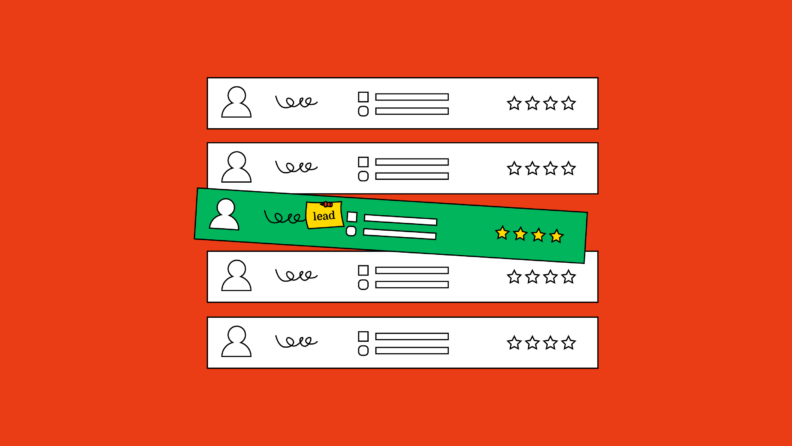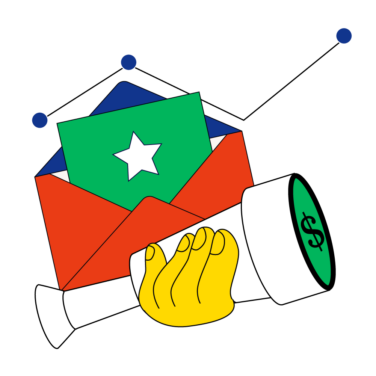Leads are the building blocks of B2B, ultimately funneling down into prospects and paying customers. Scaling your B2B lead generation efforts will fuel your growth, but it can't come at the expense of efficiency.
These are 12 of the most impactful strategies to increase your pool of leads within tight marketing budgets.
What is B2B Lead Generation?
B2B lead generation is the process of attracting and capturing businesses who may be interested in your products or services.
Taking it one step further, this process involves using specific tactics to identify, engage, qualify, and convert leads into paying customers.
A Breakdown of the B2B Lead Generation Process:
The B2B lead generation process really boils down to four primary steps:

Step 1: Identify Leads
Identify your target audience and define your ideal customer profile (ICP). This may be the most important step in the entire process.
- Use market research, data analysis, and customer segmentation to identify potential leads that match your ICP.
- Behavioral data will help you identify which companies and personas are more likely to convert.
- Layer in market data to understand where there may be low-hanging fruit versus fruit that may be harder to reach due to market dynamics at any given point.
Step 2: Engage Leads
Once you have identified potential leads, it's time to engage. Lead engagement tactics can include:
- Content marketing
- Social media
- Retargeting ads
Step 3: Qualify Leads
Even with a refined audience, it is important to note that all leads are not created equal. This is why focusing your time and energy on high-quality leads with the highest chance of converting to customers is critical.
- Leverage lead scoring models to help qualify and prioritize your leads effectively. Trust me, your sales organization will love you for doing this.
- Work with your sales organization on creating a sales process that helps them qualify leads into opportunities.
- You may want to incorporate a sales methodology into your sales process to standardize your qualification process.
Setting up these processes will help ensure there is a standardized way of how marketing and sales each qualify leads and opportunities. This is a critical step in driving accountability and improving the overall buyer’s journey.
Step 4: Close Leads
Once you have some sales-qualified leads in your sales pipeline, it is time to convert these leads into paying customers. Demonstrate the value of your solution and provide your customer with offers and incentives that will help drive revenue.
12 Ways to Improve Your B2B Lead Generation
Now that we have quickly talked about the B2B lead gen process, let’s explore 12 strategies that will help you create an effective lead generation model for your company. But remember, the best way to measure lead generation is to monitor KPIs and continually optimize your strategy based on the data.
1. Understand Your Target Audience
As mentioned above, understanding your target audience is a critical step in defining your lead generation process. Invest the right amount of time in understanding the motivation, pain points, and preferences of your target audience.
This is the first step in creating more personalized messaging that will better engage your potential customers. There are a number of marketing tools that can help you do this.
2. Use Content Marketing to Your Advantage
Create top-notch content that speaks to the challenges and interests of your audience. Establish your brand and credibility within your industry through:
- Whitepapers
- Blog Posts
- Educational Content
- Webinars
3. Earn Buyer Trust with Social Proof
Look to leverage positive reviews from social media and websites like G2 to highlight positive experiences and commitment to customer success.
Spend time creating some really engaging customer case studies and testimonials that speak to various industries, buyer personas, and use cases your products support. Building social proof can become a lead magnet for your organization when done right.
4. Optimize Your Website for Conversion
Optimizing your website for conversion is one of the highest-impact strategies you can focus on to improve your B2B lead generation strategy.
Let’s spend a minute unpacking this. There are several factors to consider, but these three can help make a big splash with your lead generation marketing efforts:
A compelling call to action
Include actionable CTAs throughout your website that reflect different parts of your customer journey.
Easy navigation
Make it easy for customers to navigate your website. Use clear labels and intuitive menus throughout different sections of your website.
User-friendly forms
Don’t you hate having to fill in a dozen fields on a marketing form to download content? Well, your potential customers hate this, too.
Ask for the essential information and try to keep fields to a minimum to increase your chances of conversion. Use data providers and solutions to help with data enrichment or lead intelligence.
5. Don't Forget About B2B Buyers on Mobile
A significant number of B2B buyers begin their search on mobile. When optimizing your site, check that it scales correctly for smaller screens or has a mobile-friendly version.
6. Embrace Email Marketing
Email marketing remains a powerful tool for lead generation when done right. In a survey from HubSpot, 51% of marketers say email marketing is the most effective marketing channel.
When building your email marketing strategy, remember:
Quality trumps quantity
When building an email list, consider the quality of that list. Who are the businesses and individuals you are hoping to target? How personalized can you make your campaigns to your audience?
Avoid purchasing email lists as they are often made up of low-quality leads and can harm your reputation.
Segmentation is key
Segment your email list based on specific data points you find important, i.e. titles, industry, and engagement level, to tailor your email content to be very specific and relevant to your audience.
The relevancy of your outreach will drive your conversion rates up and generate more engagement and demand for your products and services.
Use technology to automate
HubSpot, Marketo, and other marketing automation tools can do some really sophisticated things.
Set up automated sequences and drip campaigns. These campaigns to nurture leads send a series of targeted emails based on a set of pre-defined actions.
Take the time required to set up these tools right and you will improve your lead gen efforts through technology and automation.
7. Run A/B Tests on Key Landing Pages
Optimizing your lead gen strategy should involve lots of testing and reiteration. Experiment with different page layouts, messaging, headlines, and CTAs through A/B tests.
Make sure to review your form fields to identify the most effective elements. Once you have identified some winning formulas based on metrics, implement the changes and test again.
Remember, small incremental changes can lead to significant enhancements and create ripple effects over time. Take your time doing this right and you will surely enhance your customer experience, create cost efficiencies, and improve the conversion rates.
8. Personalize Your Website with Dynamic Web Pages
Web personalization is a strategy that involves creating unique experiences for leads visiting your website.
Imagine if you land on a company website and you are served up dynamic content based on your interest or exclusive offers that make sense to you.
This level of personalization will take time to implement and usually does involve purchasing marketing software to implement.
9. Run Campaigns Based on Competitor Keywords
Using competitor keywords is one of the oldest tricks in the book for marketers. And the truth is that many organizations continue to leverage this tactic because it is effective.
- Start by analyzing the keywords your competitors are currently ranked for and their overall SEO (search engine optimization) strategy.
- Find the keywords that align with your own products and services.
- Create targeted content and ads based on these results.
- Ensure that your landing pages from these ads are optimized for conversion.
However, simply putting your product and services in front of someone isn't enough. Make sure there is a unique value proposition as to why your lead should learn more about your solution rather than your competitors.
10. Organize Webinars to Capture New Leads
Webinars have been around for years but still remain one of the best ways to engage with potential customers.
- Host webinars through various channels and require sign-up to capture new leads.
- Provide value to your attendees and follow up with them before, during, and after your webinar.
- Include a clear call to action to drive further engagement from your audience.
11. Leverage Marketing Automation and CRM Tools
One of my favorite ways to improve lead gen output is to have robust marketing and sales process support by the best in class sales-MarTech.
Tools like marketing automation platforms and CRMs (customer relationship management software) will be invaluable as you scale B2B lead generation.
These tools can help with lead scoring, nurturing, marketing campaigns, outbound prospecting, and so much more. They're also built to follow the core principles of lead management and align data across all go-to-market teams.
12. Cultivate Strategic Partnerships
Last but not least on my list is cultivating strategic partnerships with businesses that complement your services or with industry influencers. These businesses and influencers can be a great source of referrals for your business.
Your marketing team should be actively building a partnership ecosystem where your company can collaborate on things like joint webinars or generating co-created content.
If done right, this is a win/win for both organizations as they cross-promote each other’s offerings to their audiences.
Bringing B2B Lead Generation Together
For B2B companies, improving your lead generation and lead management strategy is critical. Stay laser-focused on understanding your target audience, delivering value, and building trust. Continuously test and refine your tactics to build your base of leads.
The next step is understanding customer relationship management to create loyalty among your new customers and reduce churn.
Ready for more RevOps content? Get expert insights, software reviews, and industry news from the RevOps Team.


